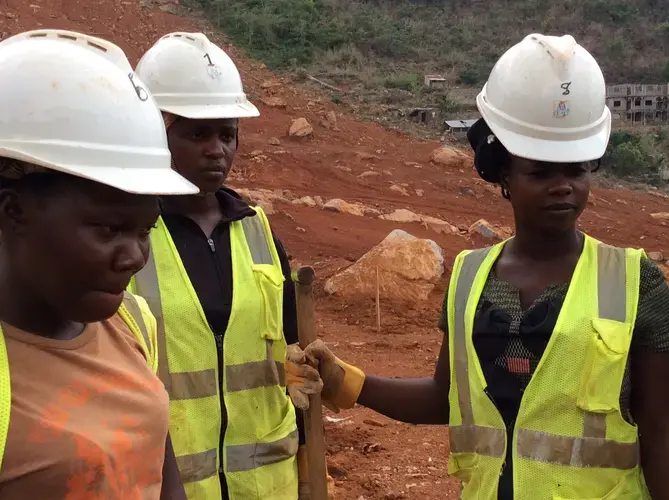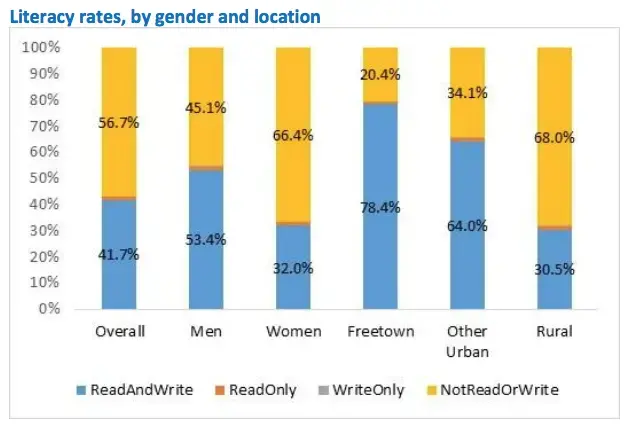
More than a thousand people were killed in a deadly landslide in Regent, a mountainous town in Sierra Leone, six miles from the capital, Freetown.
Musu Jabbie, a mother of five, lost her husband during last year’s catastrophe along with her sister, who left behind three children. Now with eight children to care for, Jabbie, 35, is doing remedial work at the same site that claimed the lives of her closest relatives.
“It’s not easy, but I am grateful,” Jabbie said.
The re-building project comes months after a torrential rainstorm filled the crevices along the vulnerable soil of Sugar Loaf Mountain causing the land to swell, according to Nicholas Gardner, a civil engineer with the United Nations Office of Project Services (UNOPS). The pressure from that swelling caused trees and boulders to break away from the mountainside, creating a tsunami of water and mud which flowed down the mountain to the valley and into the sea. The displacement of more than 3,000 residents pales only to the many who lost their lives.
More than a year later, the road to recovery is still in the making. Some initiatives on the ground are addressing the deforestation issue along with the area’s economic disparity—the two factors many believe caused the landslide.
Along this section of the mountainside, trees were removed to accommodate rapid development. According to Gardner, mass tree clearing destabilizes the ground extracting roots which help to bind the soil.
As a builder, Jabbie’s husband Musa Jabbie was on site acting as caretaker for one of the properties.
Now, Jabbie, is one of 15 women laborers working mountainside to rebuild it. A UNOPS initiative—looking to equalize the gender gap in the workforce—called for hiring an equal number of men and women to help restore the shattered mountainside.
UNOPS enlisted the help of a local employment agency to hire workers in the area. Jam Holding began their search in neighborhoods most impacted by the landslide. The company’s president, Ibrahim F. Nyomeh, asked elders within the community to submit names of people interested in post-landslide remediation, a process that followed a series of one-on-one interviews.
Jabbie of Gbangagila was among 150 women to apply.
During the implementation phase of the project the women maintained roles as site laborers and site wardens. As laborers, Jabbie and her coworkers were tasked to dig holes andremove and cart materials they found buried inside the mountain. Automobile parts, lumber, and cement blocks were some of their finds. Prying the iron rods and mesh embedded in the collapsed houses—at times with hacksaws—was, for all the workers, the most daunting.
When body parts were discovered, the Ministry of Health was contacted to avoid contamination.

In the second phase, the ground crew will plant 10 to 15 thousand trees covering a little more than 22 thousand acres of land.
Both men and women shared the 25 sets of protective gear: plastic safety boots that came within a size or two of the women’s actual shoe sizes, safety vests, and hard hats over khimars.
“Any work they do, we do,” said Jabbie, who has since moved to Motormeh after her home at the foot of the mountain was destroyed. “When they dig, we dig. When they cut, we cut.”
All the women come from Mortomeh or the neighboring villages of Kaningo, Gbangbagila and Pentagon where they say work opportunities post-landslide have since shriveled up. The labor intensive job coupled with the sweltering heat and humidity of a coastal country doesn’t negate the other responsibilities many of the women still hold.
“We still cook for our children, we still feed them,” said Jabbie. “Just because I work all day doesn’t mean that I get to go home and relax.”
Overall, the gender disparity among Sierra Leonean workers is minimal, according to a 2015 joint report from International Labour Report, World Bank and Statistics Sierra Leone. But while the number of men and women are employed equally, many of these jobs are in agriculture or street vending. Fewer than 10 percent of Sierra Leoneans are in wage employment according to the same report. And within that small group, educational attainment is relative in obtaining those positions.
In the same report, the literacy rate among men is more than double that of women, with men accounting for 64 percent of the country’s literacy rate compared to 32 percent of women.

Trudy Morgan is among the 10 percent in wage employment. The native Sierra Leonean is the Technical Coordinator for the Sugar Loaf restoration project. Morgan graduated from the University of Sierra Leone with an engineering degree and has an MBA from Cranfield School of Management.
“For me, coming back to Sierra Leone is an opportunity to work with young women,” said Morgan who has over 30 years of experience in the industry working with a U.K. firm for the past decade.
Morgan described the women as “more confident” since joining the UNOPS initiative. On site, the women expressed a sense of pride for their work and for the examples they are setting for their children. Although, admittedly, the feedback in their respective villages was split, some labeling the women as heroes while others scoffed at the idea of doing men’s work.
As for Jabbie, she eagerly awaits the end of the rainy season so she can get back to work to tackle the planting phase of the project.
“We only survive from gestures from friends,” Jabbie said. “If nothing is available, we sleep on empty stomachs.”





